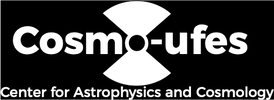SemináriosOs seminários ocorrem usualmente às 10:00 nas sextas-feiras (horário de Brasília) e são abertos a todos os interessados. São comumente apresentados em portugês ou inglês, visando alunos (graduação e pós-graduação) e pesquisadores nas áreas de astrofísica, cosmologia ou gravitação. A audiência varia, mas usualmente em torno de 20 a 40 participantes.
Há uma lista de e-mails que é aberta, aonde anunciamos os próximos seminários. Ver botão abaixo. |
SeminarsThe seminars usually take place at Fridays at 10:00 (BRT, GMT-3) and are open to all interested parties. They are commonly presented in Portuguese or English, targeting students (undergraduate and graduate) and researchers in the fields of astrophysics, cosmology, or gravitation. The audience varies, but typically ranges from 20 to 40 participants.
There is an open email list where we announce upcoming seminars. See button below. |
Organizers: Júlio Fabris, Paola Seidel, Davi Rodrigues.
